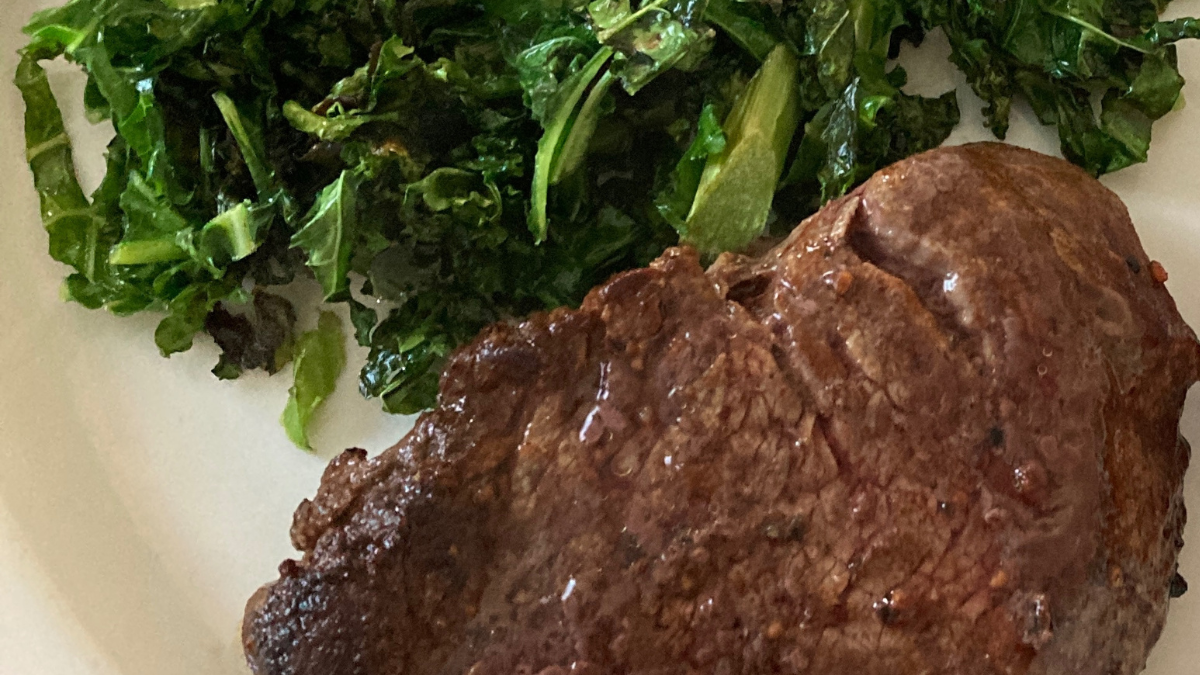If you’ve been to a fancy steak restaurant, you probably know that Filet Mignon is commonly an expensive cut of beef. It’s not the largest steak one can order, but the small round cuts are extremely tender. They have a mild beef flavor and a texture that seems to melt in the mouth. Filet Mignon at home is much more affordable than in a restaurant. I used to be afraid of cooking Filet Mignon. I feared that I would “mess up” this beautiful cut of beef. But the truth is, you can achieve a flavorful, perfectly tender Filet Mignon at home.
WHAT IS FILET MIGNON?
The cut known as Filet Mignon is the most naturally tender piece of beef you can purchase. Filet Mignon is a cut from the tenderloin, which is found beneath the ribs of a cow. Because this cut bears little weight, it is free of most connective tissue. A cut of Filet Mignon is typically 1.5-2 inches thick and often weighs around 8 ounces.
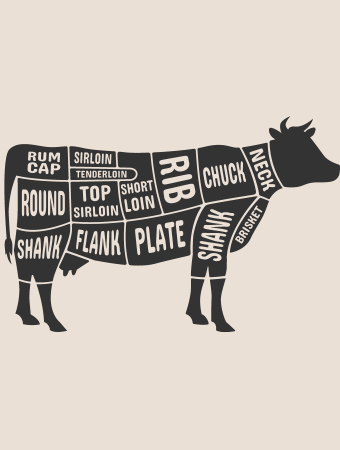
PREPARING THE STEAK
It is always best to remove thawed steaks from the refrigerator at least thirty minutes before cooking. This allows the meat to come closer to room temperature so that you do not shock the meat by moving from the cold of the refrigerator straight to the heat of a pan or grill.
Once the steaks have come near to room temperature, it’s time to season the meat. I like the simplicity of sea salt and black or white pepper. I think one key to enhancing the flavor of the beef is salt. I used to be really skimpy with salt, but have since learned to apply sea salt liberally to both sides of the filet.
GRILL IT OR PAN FRY IT?
Most of my experience with at-home steak has been with family and friends who throw steaks on the grill. I have experimented with both grilling and pan frying steaks. Pan frying consistently produces a more tender, more evenly cooked, and more flavorful steak. It is much easier to control the cooking heat. Instead of losing the natural steak juices into the flames, a pan allows the beef to sit in its natural juice and reabsorb what would have otherwise been lost.
Pasture raised and finished beef is quite lean. There is a noticeable difference between a pasture finished cut of Filet Mignon and a feed lot finished cut of Filet Mignon. A pasture raised steak benefits from added fat. While this can be done in different ways, this recipe calls for avocado oil and butter. The oil adds fat, but also allows you to cook at high heat for extended periods of time. The butter adds fat and flavor to the lean meat and caramelizes the exterior of the filet.
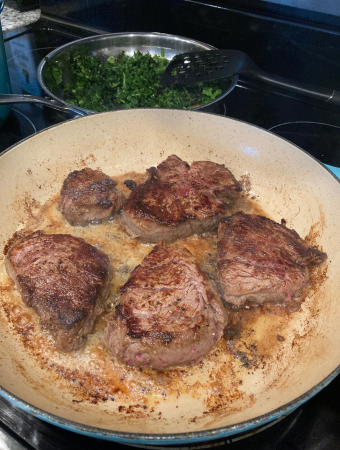
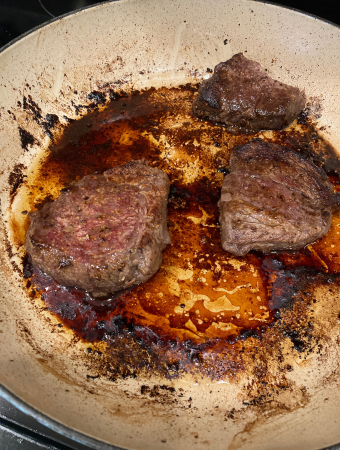
FINISHED TEMPERATURE
With grass-fed beef, traditional internal measures of temperature should lower a bit. Because grass-fed beef has less fat, cooking it to an equivalent temperature as that of conventional beef, may dry the meat and leave it flavorless. Below, see the conventional measures of internal temperature along with the suggested grass fed measures in parentheses:
- RARE 125-130F (120F)
- MEDIUM RARE 130-140F (125F)
- MEDIUM 140-150F (135F)
- MEDIUM WELL 150-155F (140F)
- WELL DONE 160 (145F)
Note: These temperatures apply to cuts of steak. The USDA still recommends that all cuts be finished to a minimum of 145F, with a rest time of 3 minutes, while ground beef be finished to 160F. Consume other temperatures with caution, only when you have a trusted source for both production and handling.
My family prefers steak to have some pink in the middle, but not be overly bloody. Because of this, I pan fry both sides and then finish in the oven for 4-5 minutes. If you prefer steaks to be more rare, pan frying both sides of the steak may produce the desired doneness. For exact measurements, use an internal, oven-safe, meat thermometer.
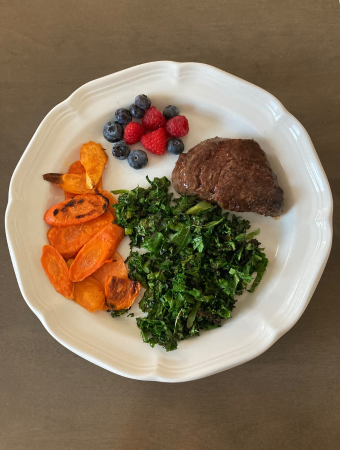
I don’t often think of steak for a weeknight meal, but it’s actually quite fast and easy to prepare. It’s a meal worthy of the weeknight rotation. Save the braising and slow cooking for the weekend.
Perfectly Tender Filet Mignon

Ingredients
– oven safe skillet or pan
– oven safe, internal meat thermometer (optional)
– tin foil
– 4 cuts of Filet Mignon, 1.5-2 inches thick
– sea salt
– black or white pepper (preference)
– 2 tbsp avocado oil (or other high heat oil)
– 3 tbsp butter
Directions
1. About thirty minutes before cooking, set the steaks out to come to room temperature. Preheat the oven to 400 F.
2. When ready to cook the steaks, heat an oven-safe skillet over medium-high heat.
3. Pat the steaks dry with a paper towel. Liberally salt each side of each steak. Add pepper as desired.
4. To the hot pan, add 2 tbsp avocado oil. Spread the oil evenly. This helps to ensure that all of each steak surface will make contact with the hot pan.
5. Using tongs, place each steak onto the hot oil. Sear for five minutes. Try not to move the steaks around while searing. That would prevent them from developing the brown crust that you’re trying to achieve.
6. When nearing the end of five minutes, add the 3 tbsp butter to the pan. Flip the steaks and nestle them into the melted butter. Cook for another 3-4 minutes. Using a spoon, ladle some of the melted butter atop the steaks while cooking.
7. For a medium steak, transfer the pan to the oven for about four minutes. Each minute longer will increase the doneness of the steak. An internal thermometer will help you to be more precise should you desire exact precision. For a more rare cut, you may not need additional cook time in the oven.
8. When done cooking, remove the steaks from the pan and transfer them to another dish. Tent them with foil. If you leave them on the hot pan to rest, they will continue to cook quite a bit. Even resting on an unheated surface, if tented, the steaks will continue to rise another five-ten degrees during the rest period. Be sure to allow at least five minutes for rest before serving.

Here on SpringForestFarm.com, Jennifer Taylor Schmidt writes beef recipes for the busy, natural homemaker. It is possible to seek optimal health with limited time and money. Join Jennifer in future posts as she explores the possibilities found in a 1/4 and a 1/2 beeve. She also offers recipes and nourishment for body, mind, and soul on RealFoodRealHealing.com.
